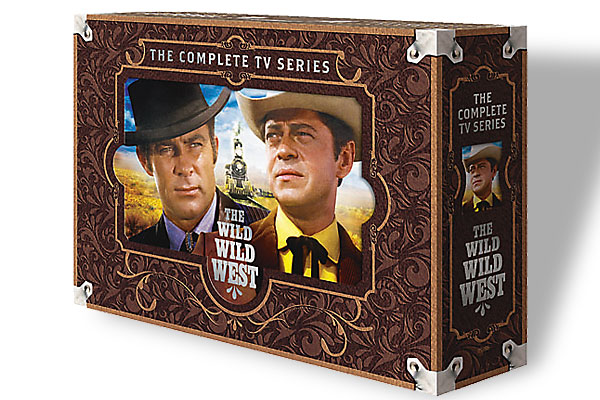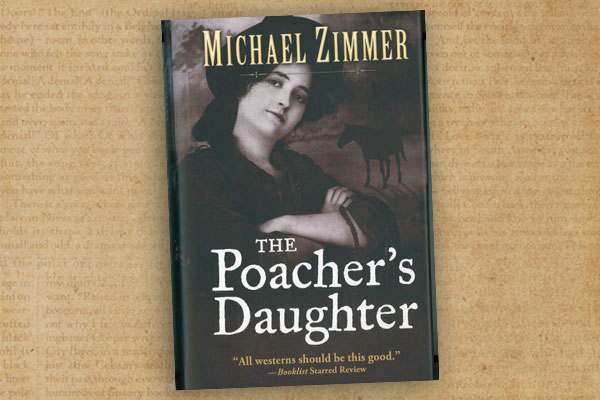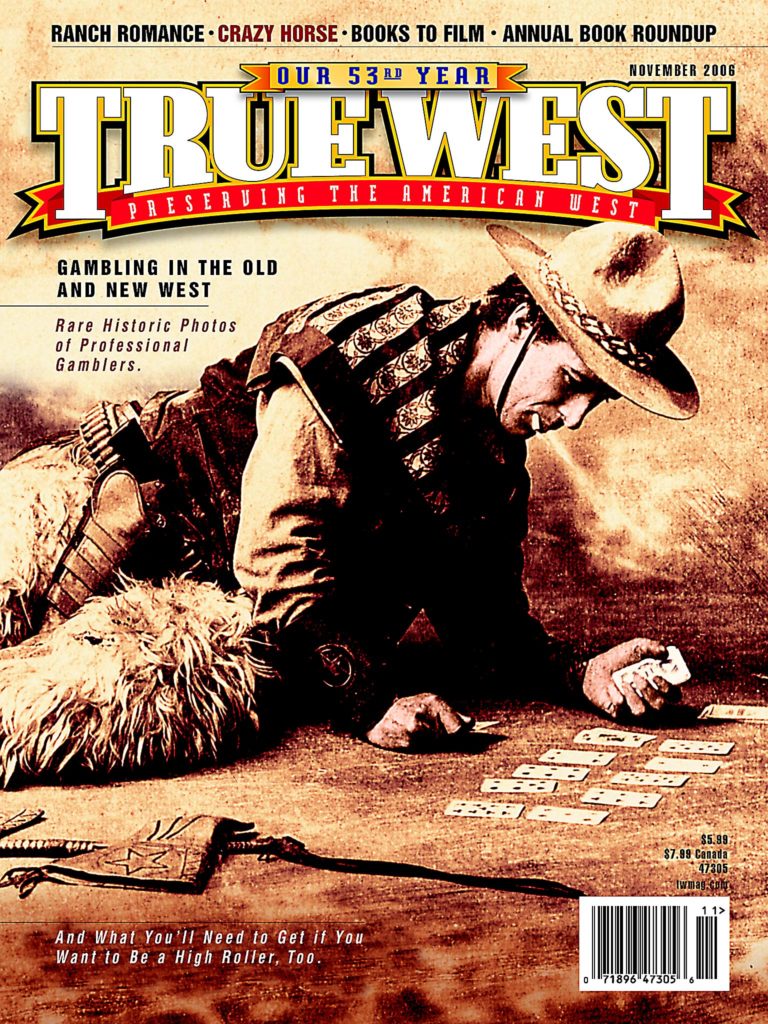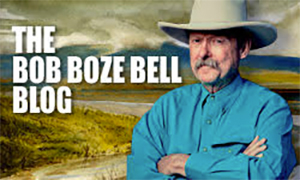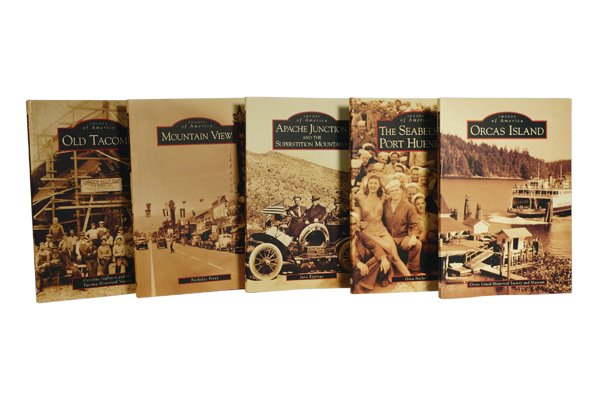 If you ask an Average Joe who has any inkling about Western history to name a series in the genre, he’s most likely going to name the Time-Life Old West series—a 26-volume set ranging from the “Cowboys” to the “End and the Myth.”
If you ask an Average Joe who has any inkling about Western history to name a series in the genre, he’s most likely going to name the Time-Life Old West series—a 26-volume set ranging from the “Cowboys” to the “End and the Myth.”
But compiling the best of the West into a series didn’t end with that set, nor did it begin with it. So we’ve come up with a list of some Western-oriented series, both nonfiction and fiction, that you should get serious about.
WESTERN FICTION
Est. 1989
Skye’s West
A former British sailor becomes a frontier scout, trapper and trader in Yellowstone Country. But what author Richard Wheeler figured would make his character, Barnaby Skye, most interesting to readers was the fact that he had two wives: a Crow, Victoria, and a Shoshoni, Mary. Skye’s binge drinking gets him into trouble on the frontier, or sometimes his horse, Jawbone, leads him right to it. The first eight books feature Skye as a middle-aged man during the 1850s-60s, while the rest take the reader back to his younger days, when he jumped ship in the 1820s. Richard Wheeler plans to release 16 titles in this series, published by Forge, but he is not yet sure if the main character will die in the last book. The series has 14 volumes to its credit.
Est. 1990
First North Americans
Award-winning archaeologists and husband-and-wife team W. Michael Gear and Kathleen O’Neal Gear first started their sweeping epic of prehistory with People of the Wolf, which tells the story of small hunting bands crossing the land bridge linking Europe and Asia to the Americas. How did this series begin? Well, the Gears were helping excavate the oldest pithouse in Utah in 1986 when Tor/Forge Editor Michael Seidman asked them what they had uncovered. When told of Fremont pithouses, pinion caches and gaming balls, he asked them if they would like to write a series following the migration of humans into North America up to the arrival of the Europeans in the 15th century. Of course, they said yes. The last book released in the series is People of the Moon, which explores the lives of the Chaco Anasazi in northern New Mexico and southern Colorado. Due out in 2007 is People of the Nightland, which takes place 11,500 years ago, when the Laurentide Ice Sheet melted. The series has 13 volumes to its credit.
Est. 1995
Tumbleweed
This series is finally complete, with the pub-lication of the last book, Will James’ Book of Cowboy Stories. The “Tumbleweed” series has reprinted each of James’ classic books, which span the years of 1927-46, four years after he died. James’ short stories and Western illustrations first began appearing in publications such as Saturday Evening Post and Scribner’s Magazine. His best-known work is Smoky, The Cowhorse, for which he won the coveted Newbery medal for children’s literature in 1927. At his memorial service, the minister remarked that James’ “soul has gone to roam the range of the eternal while his art lingers to lead those who love the West toward forgetfulness. That which he created knows no death.” Mountain Press Publishing, working with the Will James Art Company of Billings, Montana, has made sure of that by publishing this wonderful collection of his books. The complete series has 24 volumes and one bibliography to its credit.
Est. 1999
Karl May’s Winnetou
His books have outsold any other German author, and yet, Karl May’s works on the American West are virtually unknown to most Americans. One reason for that is the lack of English translations of his work. Washington State University Press is doing something about that. So far, it has published Winnetou (translated by David Koblick) and The Oil Prince (translated by Herbert Windolf). The “Winnetou” trilogy covers the adventures of Old Shatterhand and Apache Chief Winnetou. The series has inspired movies, TV series and even Karl May festivals that remain popular to this day in Germany and Austria. Visit Karl-May-Werke.de if you’d like to read the works in the original German. The series has 2 volumes to its credit.
Est. 1999
Keystone Ranch
Western literature first heard of James C. Work in 1984 when he restored Jack Schaefer’s novel Shane for the University of Nebraska Press. Then he dreamed up the Keystone Ranch, an Arthurian creation. Yes, you read that right. Work’s “Keystone Ranch” series, published by Five Star, turns the Arthurian legend of Sir Gawain and the Green Knight into an 1880s Western. His latest work, The Outcast of Spirit Ridge, is the first book in the series that doesn’t take its plot from an Arthurian legend. Instead, the focus is on the one-eyed black creature who lurks in the forests in Work’s second novel in the series, Ride West to Dawn. Work’s daughter-in-law wanted him to write another book with that character, so here it is. Like others in the series, though, the author still utilizes archetypes and tribal lore for the story. The series has 5 volumes to its credit.
Est. 2002
Westward America
Popular historical Romance writer Rosanne Bittner’s “Westward America” series, published by Forge, examines the settling of America, moving progressively westward with each installment. Her first novel, Into the Wilderness, begins in Pennsylvania, set against the backdrop of the French and Indian War. Her next novel, Into the Valley, is set in Ohio, during the American Revolution. Her latest work, Into the Prairie, takes readers to Indiana Territory and brings into the cast of characters the Shawnee leader Tecumseh. The series has 3 volumes to its credit.
Est. 2003
Rendezvous
“A fabulous beginning of what promises to become a classic series that will be on college reading lists in history classes studying the fur-trade era,” predicted Western Writers of America’s Roundup magazine, when the first in the series, So Wild a Dream, was published by Forge. If colleges haven’t gotten the hint yet, then their students are sorely missing out. Win Blevins’ “Rendezvous” series tells the story of Sam Morgan, a Pennsylvania boy who runs away from home and joins up with fur trappers in the West. When he was introduced in 2003, Morgan so captured readers’ attentions that the book won a Spur for Best Novel of the West. The latest entry in the series is Dancing with the Golden Bear, which tells of Morgan and his new bride’s first cross-continental journey to California. The series has 3 volumes to its credit.
Est. 2006
Fountain Creek Chronicles
This three-part Historical Romance series published by Bethany House and written by Tamera Alexander is set in the Colorado Territory during the 1860s-70s. Rekindled (reviewed in May 2006) introduces readers to Kathryn Jennings, who finds herself alone on her ranch after her husband fails to return home one stormy winter night. The second book, Revealed, is due out this November and will tell Annabelle Grayson McCutchens’ story. The last of the trilogy, Remembered, is expected out in the middle of 2007 and tells the story of wagonmaster Jack Brennan (introduced in Revealed) and Veronique Girard. The series has 2 of 3 volumes to its credit.
WESTERN POETRY
Est. 1990
Poetry of the American West
This splendid series put out by High Plains Press has already garnered four Wranglers from the National Cowboy Museum in Oklahoma City. Jane Candia Coleman’s No Roof But Sky began the series, including poems such as “Belle Starr Addresses the Sewing Circle,” “Two Women at the Little Bighorn” and “The Rainmaker.” The next book, due out in 2007, will be from her as well, The White Dove, about Arizona’s Father Keno. Other modern poets whose works appear in this series are: Stacy Gillett Coyle, Charles Levendosky, Laurie Wagner Buyer, Mary Lou Sanelli, Linda M. Hasselstrom and Jane Elkington Wohl. The series has 8 volumes to its credit.
WESTERN WRITERS
Est. 1972
Western Writers
These 50-page booklets published by Boise State University offer a brief, but informative, introduction to the lives and works of authors who have written significant literature about the American West. If you’ve heard of them, this series has most likely covered either the authors or their most famous work. Forthcoming titles will cover writers Alonzo “Old Block” Delano, Lew Welch and Mary Clearman Blew, and discuss Helen Hunt Jackson’s Ramona, an 1884 work often described as the first novel about southern California. The series has 168 volumes to its credit.
Est. 1985
Tarleton State Univ. Southwestern Studies in the Humanities
In this Southwestern series of literary criticism, Roger Jones discusses Victorian authors who have influenced the work of Larry McMurtry (most known for Lonesome Dove); Georg Guillemin shares the pastoral vision evident in works of Cormac McCarthy (most known for Blood Meridian); and the latest in the series, published this year, is Rob Johnson’s exploration of the lost years of the Beat writer William S. Burroughs, in which Johnson shares how the author’s cotton farm experiences in south Texas helped inform works such as Junky and Queer, and recurs as a setting in most of his other works, as well. The series has 21 volumes to its credit.
WESTERN HISTORY
Est. 1932
Civilization of the American Indian
Twenty-five years away from Indian Territory days emerged a series at the University of Oklahoma Press, conceived by Joseph A. Brandt as a way to rid the nation of a distorted view of Indians as villains and replace it with a perspective gained from those who actively took part in native culture and recorded the true customs, habits and attitudes of a people. The first book in the series was Forgotten Frontiers, edited by Alfred Barnaby Thomas, who translated documents related to Indian agent Don Juan Bautista de Anza and his efforts to pacify natives in New Mexico, noting most Anza’s expedition against the Comanche in 1779 and Moqui in 1780. The latest in the series is Crazy Horse by Kingsley M. Bray (see p. 50). Angie Debo’s The Rise and Fall of the Choctaw Republic brought the series the recognition it deserved when the 1934 book won the John H. Dunning Prize of the American Historical Association. Authors who have published works in this series include: George E. Hyde (George Bird Grinnell’s assistant on the Plains tribe), ethnologist John Adair (focus on Navajo and Pueblo silversmiths), Alice Marriott (Kiowas and Pueblos) and Joseph Epes Brown (Sioux). The series has 254 volumes to its credit.
Est. 1937
Western Frontiersmen
Book series have been a part of Arthur H. Clark ever since the publisher printed its first work in 1902, but many of the series were limited to a set number of volumes in the beginning. This is a series that remains open-ended at the press, which means new works are added whenever they fit the basic theme of the series. Mountain man Jedediah Smith to lawman Bill Tilghman to Mormon pioneer John D. Lee are among the pioneers, explorers and early settlers of the West whose lives are examined. “The manuscripts that are included are selected on the basis of their original contributions to our understanding of the Western experience, the depth of their research and the skill of the author’s presentation,” says Robert A. Clark. The first in the series is Finn Burnett, Frontiersman by Robert Beebe David; the most recently published work is Sacagawea’s Child by Susan M. Colby, who discusses the culture and times that molded little Pomp. The series has 33 volumes to its credit.
Est. 1953
Western Frontier Library
The same year this magazine first went into print was also when the University of Oklahoma printed its first book for its “Western Frontier Library” series created by Savoie Lottinville. This collection contains original narratives and eyewitness accounts, with an introduction by a modern-day authority. The first in the series is Thomas Dinsdale’s The Vigilantes of Montana, a reprint of the 1866 original, which was the first published book in Montana. The latest work is A Lady’s Ranch Life in Montana by Isabel F. Randall, who lived in Montana between 1884-86 before returning to England and publishing this collection of letters of her life in the American West in 1887. Editor Richard L. Saunders supplements the work by sketching the Randalls’ lives before and after their Montana adventure, describing the stock industry that brought them there and placing Isabel’s letters in the context of English opinions of Americans. The series has 67 volumes to its credit.
Est. 1966
Emil and Kathleen Sick Lecture
Celebrating its 40th anniversary this year, this lecture series is published by the University of Washington Press. The children of Emil and Kathleen Sick endowed a fund in their parent’s names that allowed for the publication of books based on research lectures in the field of Western history and biography. Emil Sick was an owner of Seattle’s Rainier Beer and the city’s baseball team. He was also president of the Seattle Historical Society and led the fundraising drive for the construction of the Museum of History and Industry. The first book published in this series is D.W. Meinig’s The Great Columbia Plain: A Historical Geography, 1805-1910; the latest book is Katrine Barber’s Death of Celilo Falls, about Oregon’s oldest continuously inhabited town and how the 1957 construction of the Dalles Dam ruined the traditional uses of the river for the Indians while non-Indians celebrated the hydroelectricity and the new river “highway.” The series has 13 volumes to its credit.
Est. 1976
Elma Dill Russell Spencer Series in the West and Southwest
Dan Kilgore first gave credence to the theory that Crockett was executed in his 1978 book, How Did Davy Die? published in this Texas A&M series; C.L. Sonnichsen discussed grassroots history by examining the Texas feuds and Hardin in his 1979 work, The Grave of John Wesley Hardin; and Marc Simmons told the story of the Massacre on the Lordsburg Road, shedding light on one of the last massacres of the Indian Wars. Next will come Anne H. Sutherland’s The Robertsons, the Sutherlands and the Making of Texas, a work that shares the stories of families who came to Texas in the 1830s who can help us understand the American colonization of Mexican Texas. In fact, Edna Ferber researched her 1952 book Giant, which touches on this subject as well, by taking trips with Sutherland’s father, executive secretary of the Good Neighbor Commission (created to improve inter-actions between U.S. and Mexico). As you can tell, the intent of the series is to focus on peoples and perspectives not traditionally covered in Western history. The series has 25 volumes to its credit.
Est. 1978
Time-Life Old West
The Old West left a permanent legacy of Indians, mountain men, settlers, soldiers, cowboys, gunfighters and townspeople. When the series came out, it impressed many, including Malcolm S. Forbes, publisher of Forbes magazine, founded by his father. He said the series reminded him how strongly humans desire to be remembered. A comment in the “Women” volume drove this home for him: “Many literate pioneer women seemed to sense that their lives were part of a great historical venture that would never take place again. Mollie Dorsey Sanford, an early settler in Nebraska and Colorado, asked her grandson to preserve her journal, ‘not from any special merit it possesses but because I do not want to be forgotten.’” Because of this Time-Life series, she and others like her are not forgotten. The out-of-print series has 26 volumes plus one index to its credit.
Est. 1988
Oklahoma Western Biographies
Fittingly, George Armstrong Custer takes the lead in this series by the University of Oklahoma Press. Robert M. Utley’s take of his so-called “cavalier in buckskin” is that the Boy General was a man on a quest for money who inevitably suffered the bad luck of undermining his Indian opponents as the army was prone to do at the time. The University’s latest brief, but insightful, biography is one on Hanging Judge Isaac C. Parker by Michael J. Brodhead, who reveals the story behind the man whose life is usually obscured by his sensationalist court decisions. Others profiled in the series include: Comanche Chief Quanah Parker, Western Director John Ford, Author/illustrator Mary Hallock Foote and Dramatist/fiction writer Bret Harte. The series has 20 volumes to its credit.
Est. 1993
Modern American West
Most series profiled in this feature focus on historic characters and events in the Old West, but this University of Arizona Press series provides an insightful look at what’s going on in today’s West. The first book in the series, on the federal landscape in the 20th century by Gerald D. Nash, got the following review from History: Review of New Books: “He has laid bare a glaring but not entirely comprehended reality—that without federal intervention, the American West would be an entirely different place today.” The most recent work in the series, Religion in the Modern American West by Ference Szasz, also has its critical lauds, most notably from Library Journal: “Szasz takes pains to present the unique character of Western American religious practice, marked as it is by a mixture of frontier spirit, utopian questing, a certain religious consumerism, and a philosophical eclecticism tied to a secular mind-set that thirsts after an individualistic social order.” Each book in the series makes a significant contribution to the field by pointing out new directions for others to take up more specialized research. The series has 5 volumes to its credit.
Est. 1995
Outlaw-Lawman Research Series
By training and occupation, Dr. Philip J. Rasch was a kinesiologist, an expert on the human body and its movements. But he also spent more than 40 years studying outlaws and lawmen of the Southwest. In the mid-1990s, the National Association for Outlaw & Lawmen History (NOLA) compiled Rasch’s work into a series of books. The first one—limited to 1,000 copies and edited by Robert DeArment, as are all subsequent releases—is Trailing Billy the Kid, a collection of stories about the Lincoln County War and its most famous participant. It’s now out of print, hard to find and expensive to buy. Two more books also focus on New Mexico stories before the series strays from the earlier theme. The most recent book takes an even greater turn—Outlaws & Lawmen of the Old West: The Best of NOLA features ground-breaking articles that appeared in the NOLA Quarterly, the organization’s journal, by authors including C.L. Sonnichsen, True West book reviewer Richard H. Dillon, Frederick Nolan and Nellie Snyder Yost. The series has 5 volumes to its credit.
Est. 1997
Kingdom in the West: The Mormons and the American Frontier
Source documents, many of them never before published, comprise the core of this series, published by Arthur H. Clark, which illuminates the Mormon pioneers’ religious visions and political ambitions in the frontier West. The first in the series, Pioneer Camp of the Saints, is edited by Will Bagley who presents the 1846-47 journals of Thomas Bullock, the official journal keeper of Brigham Young’s pioneer company as it made its way to the Valley of the Great Salt Lake. The most recent work is Michael W. Homer’s On the Way to Somewhere Else, revealing lesser-known European reports about early Mormons in the West, spanning 1834-1930. The series has 8 volumes to its credit.
Est. 1999
Dreamers and Schemers
This series by Lori Van Pelt and published by High Plains Press focuses on Wyoming characters. The first book profiles 31 men and women who helped shape Carbon County, from Mountain Man Jim Baker to Indian scout Bonaparte Napoleon Earnest to Copper King Willis George Emerson. The next book tackles 24 personalities in Cheyenne: cowgirl Prairie Rose Henderson, stockman Charley Irwin and former slave Barney Ford. Characters from Natrona County will be the focus of Van Pelt’s next work. The series has 2 volumes to its credit.
Est. 2000
Outlaw Tales
“Big Nose” George Parrot, Harvey Logan (Kid Curry) and the “Jesse James” of Montana kicked off this series on robbers, rustlers and bandits with the 2000 release of Outlaw Tales of Montana by Gary Wilson and published by Globe Pequot. So far, the series reveals the exploits of notorious bandits, robbers and rustlers in Washington, Montana, Arizona, Utah, Colorado, Nevada and Oregon. Next year, the press will take on California and New Mexico. The series has 7 volumes to its credit.
Est. 2005
Race & Ethnicity in the American West
Finally, a series that shows how ethnic experiences of different groups and their interaction with the majority has made the West the distinct region it still is today. Published by the University of Nebraska Press, this series begins with Sheila McManus’ The Line Which Separates, which The Journal of American History reports as presenting “an ambitious but focused study of how the drawing of a border line between Alberta and Montana was complicated by the construction of nation, race, and gender from 1860 to 1890.” The latest work is Art T. Burton’s Black Gun, Silver Star, a biography of frontier Marshal Bass Reeves who worked in the Indian Territory during Hanging Judge Isaac Parker’s reign. The press plans to release two-four books per year in the series. The series has 4 volumes to its credit.
Est. 2005
Plains Histories
The Plains region is home to the massacre at Wounded Knee, the Lincoln County War and the Dust Bowl. The rough boundary between the nation’s East and West is the subject of the first volume in this series, America’s 100th Meridian, narrated by perceptive photographs by Monte Hartman. John R. Wunder, director of the Center for Great Plains at the University of Nebraska in Lincoln, is the editor for the series, which explores the Great Plains through edited collections, biographies, memoirs and comparative studies. The first memoir in the series, Railwayman’s Son, is by Hugh Hawkins whose father worked for the Rock Island Railway during the 1930s-40s. Richard Lowitt is one of a few historians of the American West who has chronicled the 20th century, and he takes on the Oklahoma Panhandle in American Outback. Texas Tech University Press has put out a series that would make Walter Prescott Webb proud. The series has 5 volumes to its credit.
WESTERN FIREARMS
Est. 1984
Firearms of the American West
True West’s gun columnist, Phil Spangenberger, highly recommends this series by the University of New Mexico Press, calling it “the best on the subject.” Charles G. Worman and Louis A. Garavaglia cover firearms from 1803-65 and 1866-1894 in the first two works. The last volume was written as a companion piece to the first two and is titled differently: Gunsmoke and Saddle Leather: Firearms in the Nineteenth-Century American West. In all of the books, the authors clearly demonstrate how important the evolution of arms technology was to the settling of the frontier. The comprehensive coverage includes magnificent photographs and illustrations of just about every type of firearm that made its way west. The series has 3 volumes to its credit.
WESTERN TRAVEL
Est. 1986
Roadside History
Mountain Press’ “Roadside History” charts a course to the present with inspired, thoroughly researched stories that illuminate what we see today with what happened there in the past. The series begins with our own Marshall Trimble explaining all the sites in Arizona that most people would drive past without even realizing their significance. The latest in the series is, ironically, by another contributing editor of ours, Candy Moulton. She takes us through Colorado, tracing routes from the Santa Fe Trail to the Million Dollar Highway. The other states covered in this series are: Arkansas, California, Idaho, Montana, Nebraska, Nevada, New Mexico, Oklahoma, Oregon, South Dakota, Texas, Utah, Vermont, Wyoming; and one park is covered, Yellowstone Park. The series has 17 volumes to its credit.
Est. 1993
Images of America
Readers who enjoy our photo essays will get a kick out of this series! More than 200 black-and-white photographs bring to life the people, places and events that define a community or region in each book from this wonderful series that preserves our nation’s shared history. Arcadia Publishing’s first Western book in this series was Los Angeles’s Olvera Street by William D. Estrada. Authors who write for True West have published their own “Images of America,” including Sherry Monahan (Pikes Peak) and Jane Eppinga (Tucson, Tombstone and Apache Junction and the Superstition Mountains). Of its Western-oriented books, the series has 76 volumes to its credit.
Est. 1993
It Happened In …
Arizona, Colorado, Idaho, Montana, New Mexico, Alaska. Yes, it even happened in California, Nevada, Oregon, Texas, Utah, Washington and Oklahoma. It also found its way to Yellowstone and Glacier National Parks, the Oregon Trail and on the Lewis and Clark Expedition. And it narrowed in on San Antonio and San Francisco. So what happened in those places? You’ll have to pick up this series, published by Globe Pequot, to find out. Well, we’ll give you a sneak peak at what you can expect. The latest book on Oklahoma tells 30 stories, including tales about building a 900-foot Jesus, the Second Trail of Tears and taking down outlaw leader Bill Doolin, twice. Due out next spring is a book on the Grand Canyon National Park. Of its Western-oriented books, the series has 20 volumes to its credit.
Est. 2002
Visual Tour
You may know the names of the top tourist destinations of the West, such as Route 66 and the Four Corners, but you shouldn’t rely on what you can find on Google before you finally take a trip to see the sites yourself. Northland has put together a top series, which we hope will have more destinations soon, that begins with a look at Sedona, Arizona. Other spots covered in the series are indeed Route 66 and the Four Corners, as well as a look at California’s San Diego and Napa Valley. The pictures sell you on each area’s beauty, while the text shares the area’s cultural history and flora and fauna, and provides a guide to rock formations, contemporary attractions and nearby sites to visit, as well. The latest books even feature a mileage chart so you can approximate how far each location is from another. The series has 5 volumes to its credit.
WESTERN CUISINE
Est. 2006
Cook West
From Prickly Pear Lemonade to Chili and Chocolate combinations, Western cuisine is finally celebrated in this savory series by Rio Nuevo. Each cookbook focuses on a single ingredient, offering 50 original recipes as well as tips for handling and preparation. So far, the flavors of the West come alive in books sharing the secrets of cilantro, garlic, olives, citrus, chile and avocado. The latest cookbooks focus on nuts (pistachio, pecan and piñon) and the famous Mexican sauce, Mole (hence, the earlier mention of a mixture of chocolate and chilis). The only thing that could improve this series is the inclusion of pictures of all of the dishes. When you’re cooking something new, it’s nice to have an idea of how the dish is supposed to turn out. The series has 8 volumes to its credit.
WESTERN KID’S LIT
Est. 2002
Children of the West
This series won the Dorothy Woodward Award for Education in 2004, and each “True story from History” comes highly recommended for fourth grade readers and up. Written by New Mexico’s Historian Laureate, Marc Simmons, and illustrated by working cowboy Ron Kil, this series, published by the University of New Mexico Press, began with Millie Cooper’s Ride, about a courageous girl who rides through an Indian War party to rally for a relief force at a neighboring fort during the War of 1812. The latest in the series, Billy Blackfeet in the Rockies, shares the life of a 10 year old before he grows up and serves as an army scout, narrowly escaping death during Custer’s expedition to the Little Bighorn River in 1876. The series has 5 volumes to its credit.
Est. 2003
Adventures on the American Frontier
Stephen Bly has written numerous Western series aimed at kids for Good News Publishers, but this is one we particularly enjoy. The Butterfield stage (see this issue’s Renegade Roads), the Pony Express and the Transcontinental Railroad set the stage for some stories that are so entertaining, your kids won’t even realize they’re learning something. The series has 3 volumes to its credit.
Est. 2005
Stars of Texas
Important Texans who haven’t gotten the attention they deserve are finally going to be on some kids’ radar, thanks to this series written by Judy Alter, a winner of the Western Writers of America Lifetime Achievement Award, and published by Texas A&M University Press. The concise biographies are aimed at fourth graders but can also be enjoyed by older readers. So far, the series introduces Henrietta King, who ran our nation’s largest ranch, Mirabeau B. Lamar, the second president of the Republic of Texas, and Miriam “Ma” Ferguson, first female governor of Texas. Free activity books are also available online (tamu.edu/upress/MCWHINEY/mcgen.html). The series has 3 volumes to its credit.
Est. 2006
A Little House Collection
We all remember how we felt when we first read those words, “They were going to Indian country”—apprehensive, yet excited that this was the start of a story we would never forget. But there’s more to the story than just what we read in Laura Ingalls Wilder’s Little House on the Prairie. This year, Harper Collins is releasing some-thing special. The series is still available as individual books, but the publisher has produced an illustrated book (by Garth Williams) containing the first five novels: Little House in the Big Woods; Farmer Boy; Little House on the Prairie; On the Banks of Plum Creek; and By the Shores of Silver Lake. The last three received the distinguished Newbery Award for Children’s Literature. The complete series has 9 volumes to its credit.
Est. 2006
Mr. Barrington’s Mysterious Trunk
Nothing is more fitting to start off a children’s series than an adventure at the Alamo. Mr. Barrington is a Texas History teacher who brings a mysterious trunk to class and asks his students to become a part of history. The first book, Journey to the Alamo by Melodie A. Cuate, takes seventh grader Hannah, her brother Nick and her friend Jackie back in time to the Spanish mission in San Antonio, just when the battle is about to begin. The Texas Tech University Press series has just begun.


